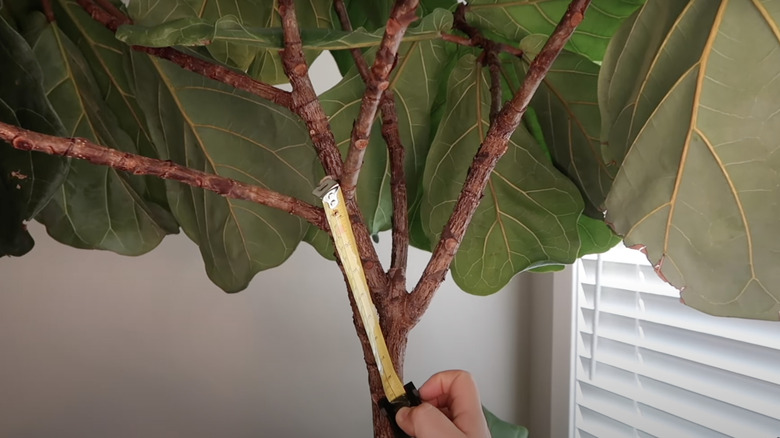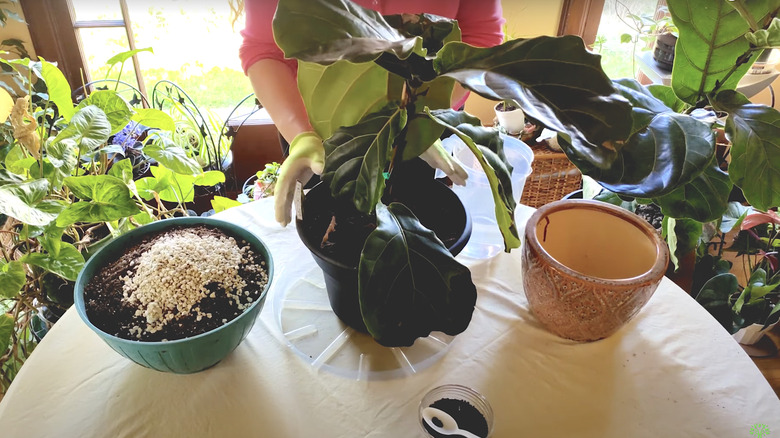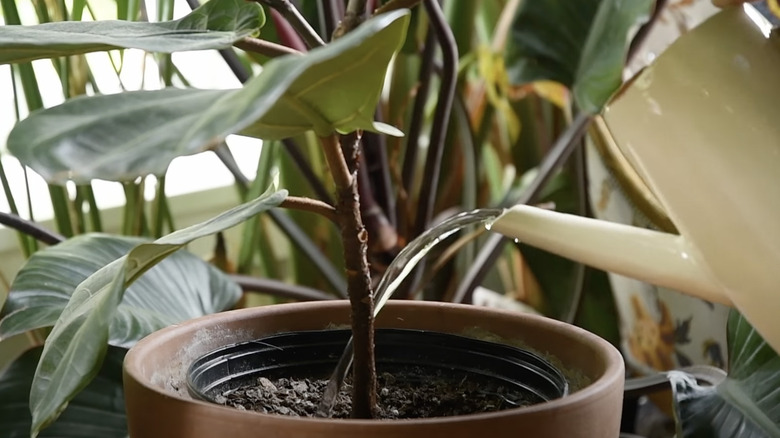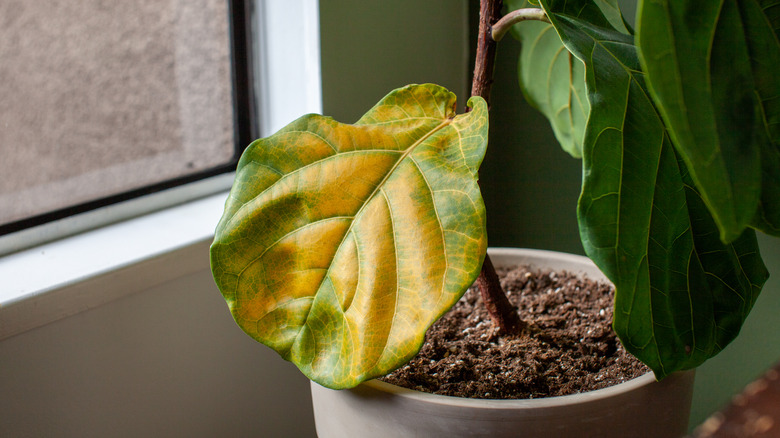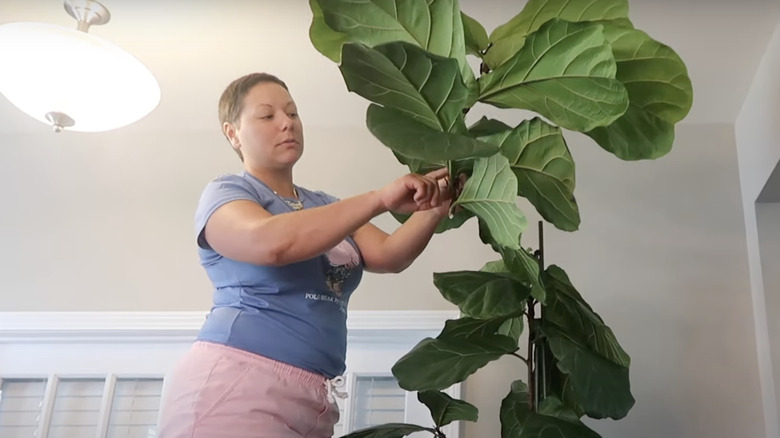Avoid These Common Mistakes When Growing A Fiddle Leaf Fig
We may receive a commission on purchases made from links.
Fiddle leaf figs reportedly entered the world of interior design in 2010, and their popularity has only soared higher as more people have embraced indoor gardening as a hobby. This plant is known by many names in the botany world and among more casual plant enthusiasts. You may recognize the terms: "Ficus lyrata," its scientific name or, "Banjo Fig," its more casual nomenclature.
Despite its soaring popularity, this ficus species is known to be a more arduous houseplant to master. Like all domesticated plants, it requires the right conditions to grow, including adequate sunlight, nutritious soil, ample watering, and routine pruning and shaping as needed. With these many steps involved in plant care, mistakes are inevitable.
However, just because mishaps are likely, especially when growing a new plant for the first time, doesn't mean you're doomed for failure. Luckily, many other gardeners before you have already made many of these mistakes. Rather than make the same ones yourself, you can learn from their experiences and skip the hardships involved. Learn more below about common gardening troubles associated with fiddle leaf figs.
Underestimating how fast and tall they grow
Fiddle leaf figs are commonly classified as houseplants, which implies they are grown indoors and in pots. While this may be true, these plants aren't necessarily like other popular houseplants. They don't work as small accent pieces for shelves and tabletops, as they often grow to heights of at least 6 feet tall and 4 feet wide. In fact, their outdoor counterparts often reach over 50 feet when they hit maturity.
In addition to their large size, these plants grow fast. When kept in optimal conditions, fiddle leaf figs grow an inch or more per month. It should be noted that their growth can slow considerably when indoors, although some avid indoor gardeners have shared stories of their plants tripling in size in just one year. Knowing the potential for your ficus is important, as you must accommodate such growth throughout the year.
Picking the wrong pot for your fiddle leaf figs
Pots are essentially plants' bedrooms, and seeing as they are where greenery spends most of their lives, you must choose these receptacles wisely. In most cases, bigger is better. A larger pot means more space for a plant to grow and stretch its roots and more soil to absorb excess water. However, you shouldn't plant a small plant in a large pot; pick one that's 2 to 3 inches larger in diameter than your plant's root ball, and then repot as needed.
In general, younger fiddle leaves can be kept in 12- to 14-inch wide containers, while mature ones thrive in 16- to 18-inch wide pots. There should be a drainage hole at the base to ensure proper drainage and prevent your plant's roots from rotting from too much excess water.
Size isn't the only thing that matters; you should also choose the right type of material for your planter. Fiddle leaf figs are a great decorative accent for any room, but you should never prioritize the look of a pot over practicality. If there is a stylistic pot you have your eye on, purchase a bigger size so you can fit a smaller terracotta pot inside. Terracotta pots are usually recommended for indoor gardening because the material absorbs excess water, further preventing accidental over-watering of plants.
Choosing the wrong potting soil
When purchasing plants, it's best not to assume the soil they come in is ideal. Many people mistakenly believe any standard potting mixture works for all houseplants. Contrary to this assumption, fiddle leaf figs prefer dirt that is humus-rich and loosely packed.
James Rivenburg, the founder of Plantandpest, recommends soil be, "-slightly acidic, with a pH level between 5.5 and 6.5." (via Homes and Gardens) He also claims ideal mixtures contain one part compost, one part peat moss, one part perlite, and one part sand. Fiddle Leaf Fig Plant has a similar recommendation, telling aspiring gardeners to use a combination of vermiculite, perlite, grit, and organic material.
However, If you're looking for a simpler combination, mix standard soil in a one-to-one ratio with perlite, sand, or cactus potting soil for similar results. Some people even buy dirt explicitly made for fiddle leaf figs. There are a few options out there, such as the Fiddle Leaf Fig Resource premium soil on Amazon or Perfect Plants soil, which is found at many chain hardware and gardening shops.
Repotting your plants without knowing when or how to do so
Repotting is an important part of plant caretaking, especially when your plants are still growing. It's a way to refresh the soil and create more space for roots as they mature, and you must know the proper method to reduce the likelihood of transplant shock. Transplant shock stops plants from absorbing and using nutrients and can weaken or ultimately lead to the death of your fiddle leaf fig.
Luckily, the process is easier than it sounds. If you're potting up into a larger container, select one that's two to three inches larger in diameter than the current one. Prepare the new pot and fill the bottom with about 2 to 3 inches of soil. To remove your plant from its old pot, slightly tip over the pot, slowly sliding the plant out of its previous home. If your fiddle leaf fig was rootbound, it'll actually be easier to slide out due to being compacted in the soil. Lightly massage the rootball to loosen the roots if it is highly compressed before carefully placing the plant upright in its new pot. Fill in the sides and top it off with the rest of your potting soil mixture. Make sure you water thoroughly and let it drain completely before setting your repotted ficus in its designated place.
Not giving your fiddle leaf fig enough light
Many common houseplants tolerate indirect light but still prefer well-lit conditions. Fiddle leaf figs are popular indoor greenery, but dim lighting does not suffice for their long-term health. These are tropical plants that grow naturally in western Africa, and they need enough light to emulate their homeland.
Place your fiddle leaf fig in front of a window that receives direct light at least six hours a day. If any outdoor trees or buildings are casting shadows over this area, it may not be sufficient. An ideal spot is in front of a large or floor-to-ceiling window facing east, west, or south to ensure they get constant sunlight throughout the day. Just make sure you don't place figs too close to windows if there are gaps that make them drafty. Warmer drafts aren't a problem, but cold drafts make plants unhappy and droopy. The easy solution is to either seal up the drafty windows or slide plants about 2 to 3 feet away from them to reduce exposure to the drafts.
Watering too often or too little
Every plant owner knows that watering technique makes or breaks your success with plants. Luckily, fiddle leaf figs aren't especially finicky when it comes to watering, but you still must be careful not to over or under-nourish them. Overdoing this practice causes root rot, mold growth, and attracts pests, while underdoing it means your ficus won't get the nutrients it needs.
Figuring out how much water your plants need can be tricky since there's no exact amount of water that works for all, even if they are the same species. The water quantities they need vary depending on individual sizes and interior climates, including the humidity and how much sunlight is present. It's recommended you water plants thoroughly once a week, allowing the excess water to drain into drip trays, sinks, or bathtubs. Of course, as fiddle leaf figs grow larger, it's more difficult to lift them up and drain them in these locations, so this technique won't be as practical in later years.
Check the soil regularly to determine when it's time to water again. Water your fiddle leaf fig thoroughly when the top 2 to 3 inches of soil feel dry to the touch.
Letting temperatures and humidity levels get too low
Western Africa is the wettest portion of the African continent and is home to the rainforests where fiddle leaf figs thrive naturally. The warm, wet climate is what this species is accustomed to, and you'll need to replicate those conditions in your own home. You'll want to avoid cold temperatures and dry air, which most noticeably affect their leaves, causing them to form brown spots and droop.
To avoid this situation, never let indoor temperatures fall below 50 degrees Fahrenheit. Temperatures between 65 to 75 degrees Fahrenheit are most ideal, and you should maintain humidity between 30 to 65 percent. This is easy for people who already live in humid climates. However, you may need to take extra steps if you live in a drier area.
When your fiddle leaf figs are young, set them in a small pot on a tray of pebbles and water. The water that evaporates off the tray will provide the humidity they need. As plants get bigger, using a tray like this may become infeasible, and a humidifier may be more practical and efficient.
Not knowing their nutritional needs
Every plant needs a combination of nitrogen, phosphorous, and potassium, which are often abbreviated as "NPK." Specialized fertilizers contain these primary nutrients at different proportions and are intended for specific plant species. This isn't as complicated as it sounds, but it is very important for plant health. Using the incorrect fertilizer can burn out their roots with excess nutrients or not provide enough. In both cases, your plants are won't thrive as they should.
You should fuel your fiddle leaf figs with fertilizers labeled three parts nitrogen, one part phosphorous, and two parts potassium. In simpler terms, look for bags with a large, "3-1-2" emblazoned on the front. You only need to fertilize them once per month throughout the growing season, spring to summer. Once autumn comes around, only fertilize them twice until the next warm season hits.
Not pruning to encourage growth
One of the reasons fiddle leaf figs are so popular is because of their customization potential. Depending on how you prune them, these plants can be sculpted into a single tree-like shape or as multiple trunks. While pruning provides opportunities to customize, it is also necessary for plant health. Neglecting to prune them as they grow may cause these ficus to mature too vertically and not in a lateral formation. This minimizes how much light they receive through nearby windows, severely affecting their sunlight intake.
Snipping the top of fiddle leaf figs is the best method to encourage horizontal growth. The more you cut off the top, the more outward branching that will occur. Make sure you cut just above a node, which is one of the bumps in the stem, and don't remove more than one-quarter of the plant at a time, as this can shock and kill them. Expect new growth to form beneath a cut within a few weeks of pruning.
Forgetting to sanitize tools before pruning
When you prune plants, you snip off their "body parts" and leave open wounds behind. The exposed stems and sap become vulnerable to bacteria, making plants especially susceptible to diseases. If you use a blunted tool covered in rust and old sap to make these cuts, it'll be a sloppy job. This makes plants heal slower and increases their risk of bacterial exposure.
To avoid such instances, you must properly sharpen and wash your tools before getting to work. Sharpen along the beveled edge of the blades using a manual or electronic sharpener. Once the tool is sharpened, you should use an abrasive pad like wire wool to remove old leaf sap and other dried residue. Wipe down the shear blades with disinfectant that is at least 70% isopropyl alcohol. You can also use chlorine bleach as long as you dilute it to a 10% solution and rinse the blades with water afterward.
Ignoring brown spots until plants are beyond help
You may not notice the little brown spots that start popping up on your plants' leaves at first, especially if your figs are several feet tall and have more surface area for you to inspect. Brown spots crop up due to many possible issues. They could be from too much or too little water, resulting in root rot or dryness. They could also be signs of infection from fungus, bacteria, or insects. These problems have a better chance of being fixed when caught in the earlier stages. However, if you don't notice them until your plants are truly suffering, you'll be wishing you'd discovered them sooner.
The best way to avoid this grievous mistake is to keep an eye on your plants throughout the year. When you're watering, fertilizing, and pruning, don't neglect to perform a quick inspection of the leaves. Check the upper and undersides to ensure no unsightly marks have formed since you last checked their appearance. If your plants are still young and small, you may want to use a magnifying lens or similar tool to get a closer look.
Leaving plants within reach of small children and pets
Parents and pet owners must be extra vigilant when it comes to raising indoor plants. While most adult humans have the common sense not to taste test plant leaves and stems, children and animals can be overly curious about such substances. They consume parts of plants, which detriments both the greenery and their own health.
Fiddle leaf figs are toxic like other similar species. They have a milky sap that irritates the skin when touched and stomachs when ingested. However, they are on the lower end of toxicity ratings, only reaching a level 4 (via Homes and Gardens), meaning they aren't too dangerous compared to other plants out there.
To keep all the aforementioned parties safe from one another, you should keep your fiddle leaf figs out of reach. Raise them in rooms with closed doors or on patios where children and animals can't access them without supervision. You can also try spraying vinegar or a citrus and water concoction on plant leaves, which creates a lingering scent known to deter cats.

